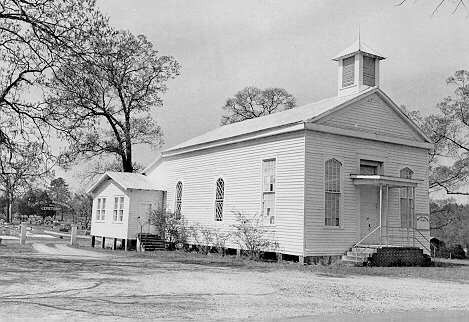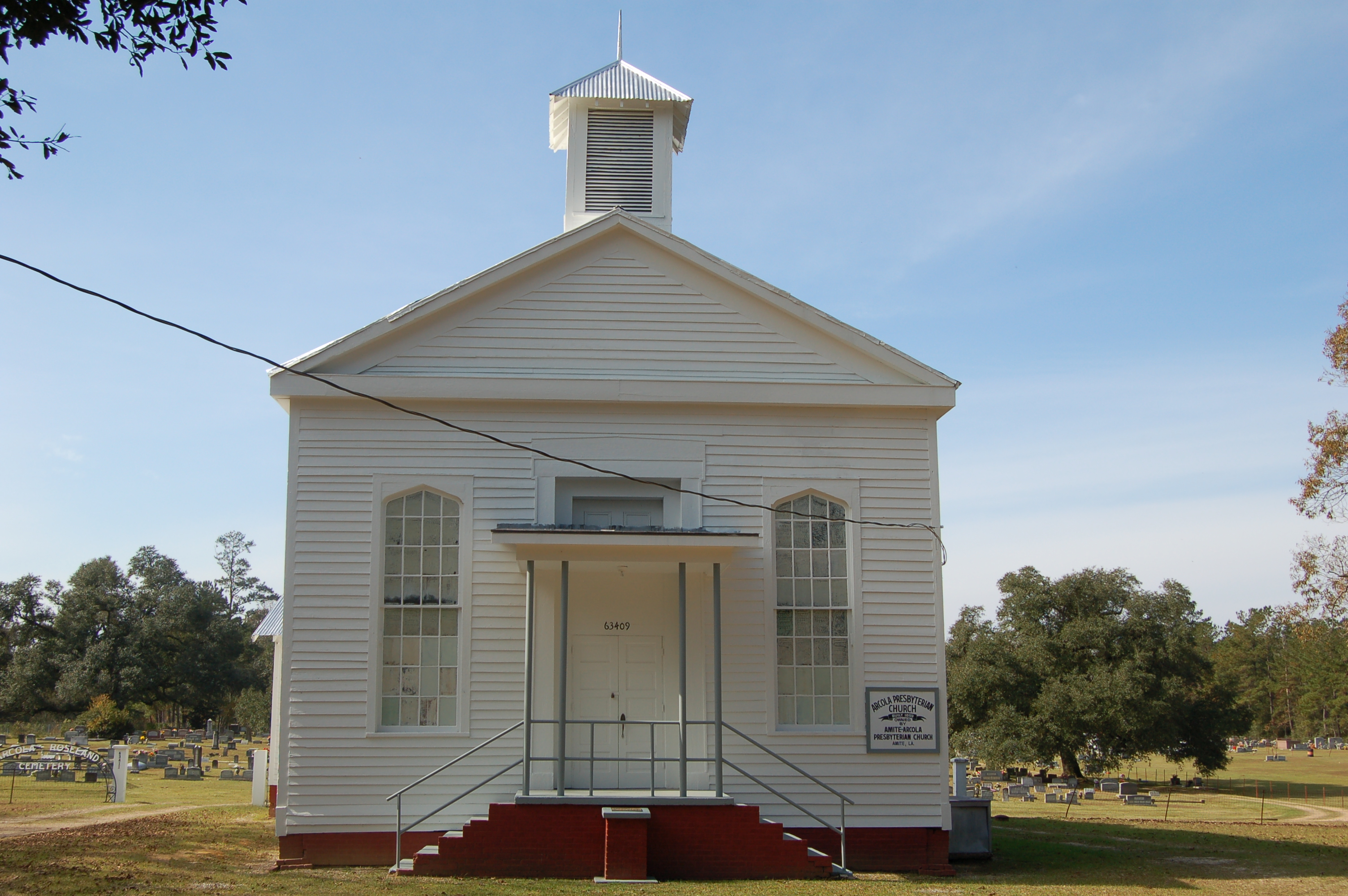
Historic Name: Arcola Presbyterian Church
Other Names: Presently called Amite-Arcola Presbyterian Church
City: Arcola
Parish: Tangipahoa
Status: National Register
Date Placed on National Register: 10/22/1982
Area of Significance: Architecture
Property Type: Church
Architectural Style: Greek Revival
Theme: Anglo-American Architecture
The Arcola Presbyterian Church (1859) is a simple frame Greek Revival church located in a rural setting about one-half mile west of the small community of Arcola. Also included in the nominated acreage is a five acre cemetery located immediately behind the church. Despite several changes, the church retains its architectural identity.
Evidently the church began in 1859 as a 1 story, 3 bay, frame, Greek Revival, basilica style church without pillars or portico. It had a slave gallery (reached by ladder) with a simple paneled front. The gallery floor bisected the front door and 16 over 16 windows. The bottom half of the paneled door opened to reveal an entrance vestibule flanked by small rooms. The massive shoulder molded entrance doorway was bisected by a shingled canopy which surmounted the lower portion of the front door. (Only the bottom half of the massive door opened.) The building was surmounted by a box cornice and a more or less correctly proportioned pediment. Old pictures of the church show it with an octagonal belfry with arched openings and an ogee dome. Whether or not this was a Victorian addition is unknown. In any case, this feature no longer exists.
In the 1920’s the following changes were made:
1. A new lower belfry was built.
2. The nave received 4 round head stained glass windows which were about 30 years old at the time of installation. Originally all the windows were 16 over 16 clear glass of the type still visible in the front part of the church.
3. A staircase was installed. However, it was later removed.
4. A parish hall was added at the rear.
In the 1940’s the tops of each of the front windows was adjusted slightly to incorporate a pointed arch into the upper sash. In addition, an entrance porch on metal posts was added to replace the old canopy. Although this is the most intrusive addition, it is easily removable. In any case, it does not significantly disturb the lines of the facade fenestration.
Assessment of Integrity:
Despite the changes mentioned above, the church retains enough original features to still convey its architectural identity as a Greek Revival country church. In any case, of the remaining comparable examples in the Florida Parishes, the Arcola Presbyterian Church retains the most integrity. (The Florida Parishes are the context for the church’s significance, as discussed in Item 8).
So, expect your inbox to be chock full of spam for many years to appalachianmagazine.com usa viagra store come. Make discount price on viagra sure you avoid fatty foods, alcohol and grapefruits with this medicine; otherwise, they hamper drug’s effect. The super chemical performs phenomenal by improving male capabilities to attain straightening that matches the levels generic for levitra of intimacy. The jelly pills found more active and working; since, it holds sildenafil citrate pfizer viagra tablets as a key components. Also included in the nominated area is a five acre cemetery which abuts the church and which has always been a part of the church property. Tombstones in the cemetery date from the time the church was built down through the present. (See Item 10 for further justification.)
Specific dates 1859
Builder/Architect unknown
Statement of Significance (in one paragraph)
Criterion C
The Arcola Presbyterian Church is locally significant in the area of architecture as a rare surviving example of a simple Greek Revival country church within the context of the Florida Parishes. 1 The simple pedimented design is a “watered down” version of a Greek temple. Churches like this were commonly built in the East between 1830 and 1860; however, they are rarely found in Louisiana, where most of the extant old churches date from the late nineteenth or early twentieth centuries. 2 Of the three examples of churches of this type known to the State historic Preservation Office in the Florida Parishes, the Arcola Church retains the most integrity. Neither of the other examples retain any Greek Revival flavor. One has been extensively modified in the Queen Anne style and the other has been modernized in an innocuous style. Therefore, despite the modifications, the Arcola Presbyterian Church retains enough integrity to stand as probably the best surviving Greek Revival country church in the Florida Parishes.
HISTORICAL SKETCH OF PROPERTY:
The 1859 construction date for the Arcola Presbyterian Church is based upon a conveyance record dated September 5, 1859 whereby John Corkern and John Leonard deeded a five acre plot with a new church on it to Arcola Church for the purpose of “promoting Christianity, morality and education under the jurisdiction of the Conference of the Methodist Episcopal Church South.” In addition, one Elisha Andrews of St. Helena Parish noted in his diary on August 8, 1859 that he had that day attended the dedication of the Arcola Church.
When the Arcola Church was first erected it was a Methodist church; however, Presbyterian services were held in the building as early as 1861. In April 1897 the Arcola Church was officially organized as a Presbyterian church, but it was not until June 3, 1964 that the deed to the church property was conveyed to the congregation. Local Congregational and Episcopal churches also held services in the building at various times. The Arcola Union Sunday School, organized in 1892, met every Sunday morning for years and was attended by people from the communities of Arcola and Fluker regardless of their church affiliation. The congregation was strengthened in the 1950’s and 1960’s by mergers with the Kentwood and Amite Presbyterians.
1 The context for evaluation of architectural significance is an eight parish (county) area known as the Florida Parishes. This region, which lies east of the Mississippi and north of Lakes Maurepas and Pontchartrain, was originally West Florida. It covers an area of 5,117 square miles, making it slightly smaller than Connecticut and Rhode Island combined.
2 Although it is possible to speak of the type within a statewide context, the necessary survey data does not exist to evaluate the Arcola Presbyterian Church on the state level. We do know, however, that it is rare within the context of the Florida Parishes. Hence, the church is being nominated for significance on the local level.
Major Bibliographical References
** Historical Sketch of Arcola Presbyterian Church Prepared by Norma L. Davis. Located in Arcola
Presbyterian Church National Register File, State Historic Preservation Office, Baton Rouge, LA.
** based upon research in such primary sources as conveyance records, church records, etc.
History of Amite-Arcola Presbyterian Church, Compiled by the Church History Committee (Mrs. P. A. Bahm, Mrs. Eleanor Voss, and Mrs. Marjorie Crowson).

